| |
| |

Johan Barthold JONGKIND, Dutch landscape
painter, mainly lived in France where he was highly esteemed
by the artistic community and art lovers.
Known as "the painter of Honfleur and Paris streets",
Manet used to call him "the father of
the modern landscape", and young painters such as Monet,
who was his pupil at his beginnings and called him his "true
master", were seduced by his stylistic daring and his landscapes
which, as soon as 1860, were signs of
Impressionism.
This points out that Jongkind work was essential to the
development of Impressionism, which is all the more surprising since
Jongkind arrived in France (in 1846) after he received in his native
country a very strong and traditional training as a Dutch landscape
painter that did not predestinate him for Impressionist-like painting.
Whereas Jongkind work speaks for itself, it can be seen
also as a link between the works of Corot and
Monet, a sign of the forecoming Impressionist wave of the late
19th century.
|
|
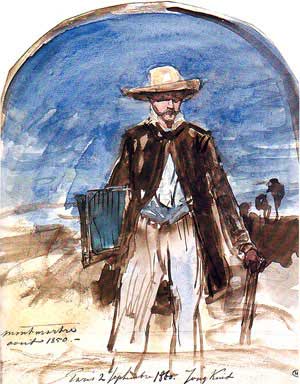
|
Portrait
of the artist by himself
1850 (annotated in 1860)
Graphite (20,5x17 cm)
Musée d'Orsay, Paris

|
 JONGKIND, DUTCH LANDSCAPE PAINTER JONGKIND, DUTCH LANDSCAPE PAINTER
Jongkind was born in Lattrop, in the eastern part of The
Netherlands, in 1819, eightht of a family of ten children, but will
spend his childhood in the harbour of Vlaardingen
on the Meuse River, the west of Rotterdam harbour, where his father was
appointed as tax collector.
In 1835, he lives school to work as a junior clerk at a
notary's office.
After his father died in 1836, he moves to The Hague
to attend drawing studies at the Academy of Arts, before
studying in the workshop of a landscape Master, Andréas Schelfhout
(1837).
|
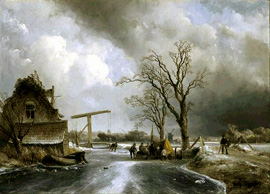
Winter scene in Holland
1846
Gemeentemuseum, La Haye
|
|
Until 1845, he will follow a solid training as a
landscape painter according to the Dutch tradition,
his works being inspired from famous painters of the "Dutch Golden
Century".
In this beginning of the 19th century, Dutch artists
revisit their history and come back to the painting of Vermeer,
Backhuysen, Van der Neer, Van de Velde...
Jongkind paints from nature classic themes of his
country such as harbours, boats, canals, windmills, winter
scenes with ice skaters... in a realistic manner in
continuation of Dutch naturalists.
|
In 1845, he will be noticed by Eugène Isabey,
the leader of the French Romantic school, who is in The Netherlands and
invites him to become his student in his Paris studio.
At the same time Jongkind is recommended to the Prince of
Orange (future Guillaume III) who grants him subsidies and the
necessary allowance so that he can go to Paris (this grant will end in
1852). Jongkind takes French lessons which, all his life and in spite
of the number of years spent in France, he will pronounce and write
with a lot of fantasy!
 JONGKIND, PAINTER OF PARIS JONGKIND, PAINTER OF PARIS
Jongkind arrives in Paris in March of 1846, deeply impregnated
with this cumbersome inheritance as a dutch landscape painter.
He will work in the workshop of Isabey, and study in the studio of
Picot. He will also get acquainted with many painters, especially Barbizon
School's painters.
Surprisingly, when one would expect him to paint the Paris of
monuments and wide open spaces, he will apply himself to paint close-up
views of Paris, slices of life he observed.
Jongkind looks at Paris with an acute and new eye, and his painting
evolves with a new langage, new ranges of color and light, and a
research for pictorial representation of light.
| |
Jongkind stays away from crowdy areas of
Paris, and prefers to paint a realistic Paris by capturing
daily working scenes,as in "The Pont Royal seen from the Quai d'Orsay, and the
lifting machine" (1852), or "Notre-Dame
of Paris seen from the Quai de la Tournelle" (1852) and "Le
Pont de l'Estacade" (1853).
Jongkind does not only paint a
landscape, he gives life to daily scenes he meticulously observed and
drew, here the unloading of a berthed barge.
He gets more interested in industrial
modernity (the lifting machine) and urban development
(the recent Palais d'Orsay on the right) of Paris, than in glorious or
touristic aspects of Paris. One can find there again the deep
naturalism of Jongkind, but now tinted with a new light which
contrasts with the heavy and dark colors of his beginnings.
|
|
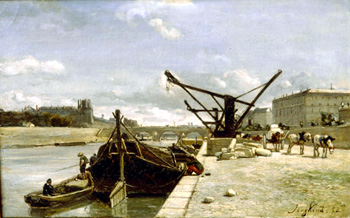
Le Pont Royal
seen from Quai d'Orsay
and the lifting machine
1852
Musée Salies, Bagnères de Bigorre
|
Jongkind sets up a new way of working
: outdoors, he draws quick watercolored sketches,
where colored touches allow him to seize instantaneous impressions,
that he possibly annotates with handwritten comments. Then, he will
later compose in his studio a more elaborate and constructed painting
based upon several of these sketches as well as his memories. He
innovates too by getting a brighter palette and by introducing in his
paintings small strokes of various colors to translate the analytic
decomposition of light and to better render changing effects
(reflection, heavens...)
All throughout his life, Jongkind will keep on
painting Paris, of which he will write, once he had returned to his
country (between 1855 and 1860), : "It is Paris where I am
recognized as a painter". But he will also, during this first stay
in France, fell in love with the Norman Coast that he discovers in 1850
while travelling from Dieppe to Le Havre with Isabey. He will exhibit "View
of Harfleur port " at the Salon of 1850, that will be
unanimously appreciated by art critics.
After his mother died in 1855, Jongkind
goes back to Holland and lives in Rotterdam, where he will
return to more traditional paintings. Until his return to Paris in
April 1860, he corresponds with his art dealer, the Père Martin.
Jongkind will send him paintings to sell, and Martin will regularly
send 100 francs notes to Rotterdam.
On Comte Doria's initiative,
with the help of painter Adolphe-Félix Cals and Père
Martin, a sale by auction of works of 88 artists
including Corot, Isabey and Rousseau is set up on 8th of April 1860 to
the benefit of Jongkind, in order to make his return to Paris possible.
 JONGKIND, PAINTER OF THE
NORMANDY COAST JONGKIND, PAINTER OF THE
NORMANDY COAST
Jongkind is back to Paris and will then live in
France until the end of his life. He settles 9, rue de
Chevreuse (today 5), in the area of Montparnasse, in an apartment that
he will keep until his death.
Soon, at the Père Martin's store he becomes
acquainted with a Dutch painter, Mrs Joséphine Fesser,
with whom he falls in love and who will become his partner. Weakened by
his melancholic disposition, familiar with brothels and filles de joie,
always short of money, Jongkind will find with Joséphine a strong woman
who was to help him to overcome his difficulties. She will also have
him visit the country, especially, as soon as 1861, the Nivernais area
where he painted "The ruins of Rosemont castle "
that will be exhibited at the Salon des Refusés of 1863.
In 1862, Jongkind gets acquainted with Boudin
and Monet, with whom he goes painting to Le Havre. Monet
will later express his debt to Jongkind by writing that he became,
after Boudin, his master and that "he completed the definitive
education of his eye".
|
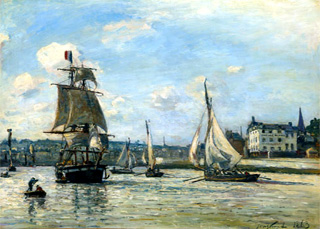
Entrance to Honfleur port
1863
Toledo Museum of Art, Ohio
|
|
|
Every summer, Jongkind
returns on the Norman Coast, between Trouville and Honfleur. There, a
deep change takes place in his work, points of view are getting larger
and more diversified, and the subtil game of light becomes
the central element of his paintings and watercolours. He applies
himself to better translate it by means of multiple decompositions in small
colored strokes, avoiding dark and flat colors he used to
paint low and cloudy heavens at his beginnings.
Jongkind stands by his
roots, his love for sea and ships, his education as a naturalist
painter, demanding observer of the real world : far from the crowdy
world of estivants, he prefers the approaches to harbours where he
paints fishermen or sailors at work.
|
It is this Norman period of Jongkind which situates him as the
precursor of Impressionism that he will remain
in regard of art history. His friendship with Manet
and Monet during his sojourns at the
Saint-Siméon farm in Honfleur, where they will found a school,
also entitles him to this designation. But, from that time, it is his
entire work, not only his seascapes, which deserve
this qualification, even when he is painting far from the sea, in the
Nivernais or Dauphiné areas.
| |
In 1868, Jongkind makes a series
of Demolitions in Paris (watercolors and oils), far
from merchant streets and touristic boulevards, where he represents men
and horses at work.
Emile Zola will
then for the first time speak in praise of Jongkind in an article for
the Salon of 1868.
|
|
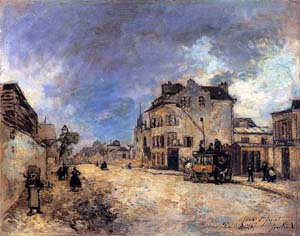
The stagecoach,
Faubourg St-Jacques street
1867
Private Collection
|
Jongkind will then have a good reputation in
France, he is idolized by young people, and his works, sunsets,
seascapes, moonlights, are much sought after by art collectors.
Every fall, he returns to Belgium and The Netherlands.
 JONGKIND'S
RETIREMENT IN DAUPHINE JONGKIND'S
RETIREMENT IN DAUPHINE
The franco-prussian war of 1870 will drive Jongkind and Mrs
Fesser far from Paris, in Nantes then in Nevers.
| |
Jongkind is a solitary worker
who avoids salons and social gatherings. Neither has he a profile for
being a movement leader.
In 1873, he submitted his painting "Moonlight
in Rotterdam" to the Salon, for which he
expected a medal. Since it was rejected, he got extremely disappointed
and decided to no longer submit nor exhibit works at the Salon.
The year after, he will also refuse to
take part in the 1st Exhibition of the Impressionist
group.
Jongkind will stay in the background of
the developing Impressionist movement. Maybe this explains why he will
not become as famous as his Impressionist friends, although they were
admiring his work so much !
|
|

View of Anvers port
1873
Municipal museum of The Haguen
|
Gradually, he will take his distance with parisian life,
definitely settling down in 1878 in the house Mrs Fesser's son bought
in la Côte-Saint-André, a small village in the
Dauphiné area near Grenoble. There, he will lead a quiet life until the
end of his life, except for a few trips in Provence
and regular sojourns in Paris, where he comes every
winter to work.
|
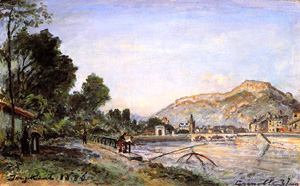
Banks of Isère river at Grenoble,
spring time
1886
Private Collection
|
|
In the Dauphiné, far from Paris or the
sea, the subjects of his paintings become less and less significant,
his work being concentrated only on light effects.
Jongkind comes to minimize
subject's importance in a painting,
before the Impressionists, who will later reject it definitely.
|
|
|




![]() JONGKIND WATERCOLORIST
JONGKIND WATERCOLORIST